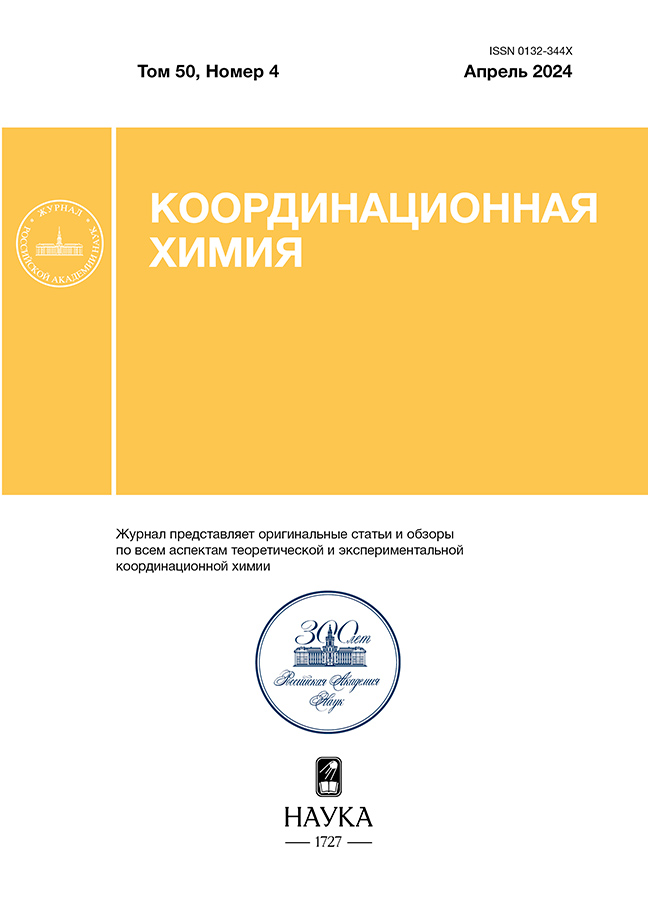Influence of the Eliminated Ligand Structure on the Reduction Rate of the Cobalt(III) Complexes
- Authors: Nikovskii I.A.1, Spiridonov K.A.1,2, Dan′shina A.A.1,3, Khakina E.A.1, Nelyubina Y.V.1
-
Affiliations:
- Nesmeyanov Institute of Organoelement Compounds, Russian Academy of Sciences
- Moscow State University
- Moscow Institute of Physics and Technology (National Research University)
- Issue: Vol 50, No 4 (2024)
- Pages: 251-260
- Section: Articles
- URL: https://rjonco.com/0132-344X/article/view/667605
- DOI: https://doi.org/10.31857/S0132344X24040039
- EDN: https://elibrary.ru/NPVTSR
- ID: 667605
Cite item
Abstract
The reduction of the heteroleptic cobalt(III) complexes with bipyridine ligands of different structures of the model drug molecule is studied by in situ NMR spectroscopy. The nature of the ligand eliminated during reduction is shown to exert a substantial effect on the reduction rate, which indicates that an optimum amount of cobalt should be chosen for the redox-activated delivery of a certain drug.
Full Text
About the authors
I. A. Nikovskii
Nesmeyanov Institute of Organoelement Compounds, Russian Academy of Sciences
Email: khakina90@ineos.ac.ru
Russian Federation, Moscow
K. A. Spiridonov
Nesmeyanov Institute of Organoelement Compounds, Russian Academy of Sciences; Moscow State University
Email: khakina90@ineos.ac.ru
Russian Federation, Moscow; Moscow
A. A. Dan′shina
Nesmeyanov Institute of Organoelement Compounds, Russian Academy of Sciences; Moscow Institute of Physics and Technology (National Research University)
Email: khakina90@ineos.ac.ru
Russian Federation, Moscow; Dolgoprudnyi
E. A. Khakina
Nesmeyanov Institute of Organoelement Compounds, Russian Academy of Sciences
Author for correspondence.
Email: khakina90@ineos.ac.ru
Russian Federation, Moscow
Yu. V. Nelyubina
Nesmeyanov Institute of Organoelement Compounds, Russian Academy of Sciences
Email: khakina90@ineos.ac.ru
Russian Federation, Moscow
References
- Jungwirth, U., Kowol, C.R., Keppler, B.K., et al., Antioxid. Redox. Signaling, 2011, vol. 15, p. 1085.
- Brown, J.M. and Wilson, W.R., Nat. Rev. Cancer, 2004, vol. 4, p. 437.
- Denny, W.A., Cancer Invest., 2004, vol. 22, p. 604.
- Graf, N. and Lippard, S.J., Adv. Drug. Deliv. Rev., 2012, vol. 64, p. 993.
- Ware, D.C., Siim, B.G., Robinson, K.G., et al., Inorg. Chem., 1991, vol. 30, p. 3750.
- Craig, P.R., Brothers, P.J., Clark, G.R., et al., Dalton Trans., 2004, vol. 4, p. 611.
- Failes, T.W., Cullinane, C., Diakos, C.I., et al., Chem.-Eur. J., 2007, vol. 13, p. 2974.
- Karnthaler-Benbakka, M.S.C., Groza, M.S.D., Kryeziu, M.K., et al., Angew. Chem., Int. Ed. Engl., 2014, vol. 53, p. 12930.
- Palmeira-Mello, M.V., Caballero, A.B., Ribeiro, J.M., et al., J. Inorg. Biochem., 2020, vol. 211, p. 111211.
- Souza, I.S.A., Santana, S.S., Gomez, J.G., et al., Dalton Trans., 2020, vol. 49, p. 16425.
- Khakina, E.A., Nikovskii, I.A., Babakina, D.A., et al., Russ. J. Coord. Chem., 2023, vol. 49, p. 24. https://doi.org/10.1134/S1070328422700105
- Cioncoloni, G., Senn, H.M., Sproules, S., et al., Dalton Trans., 2016, vol. 45, p. 15575.
- Vlcek, A.A., Inorg. Chem., 1967, vol. 6, p. 1425.
- Ma, D.-L., Wu, C., Cheng, S.-S., et al., Int. J. Mol. Sci., 2019, vol. 20, p. 341.
- Sheldrick, G.M., Acta Crystallogr., Sect. A: Found. Crystallogr., 2008, vol. 64, p. 112.
- Dolomanov, O.V., Bourhis, L.J., Gildea, R.J., et al., J. Appl. Crystallogr., 2009, vol. 42, p. 339.
- Stamatatos, T.C., Bell, A., Cooper, P., et al., Inorg. Chem. Commun., 2005, vol. 8, p. 533.
- Alvarez, S., Chem. Rev., 2015, vol. 115, p. 13447.
Supplementary files



















